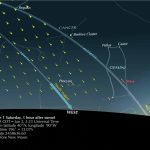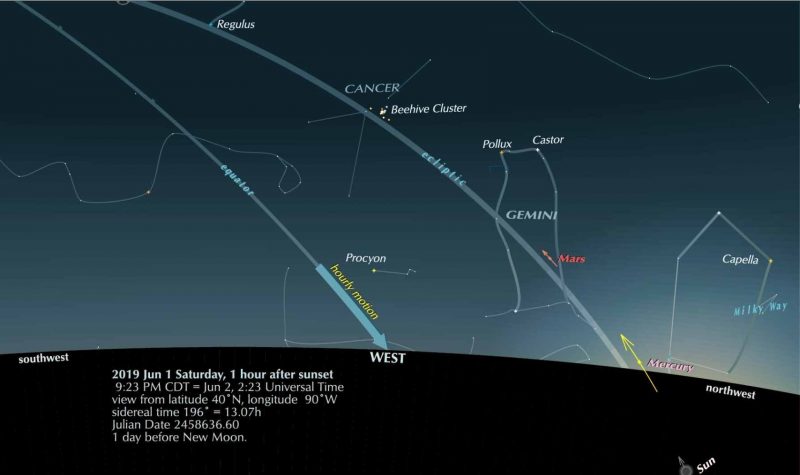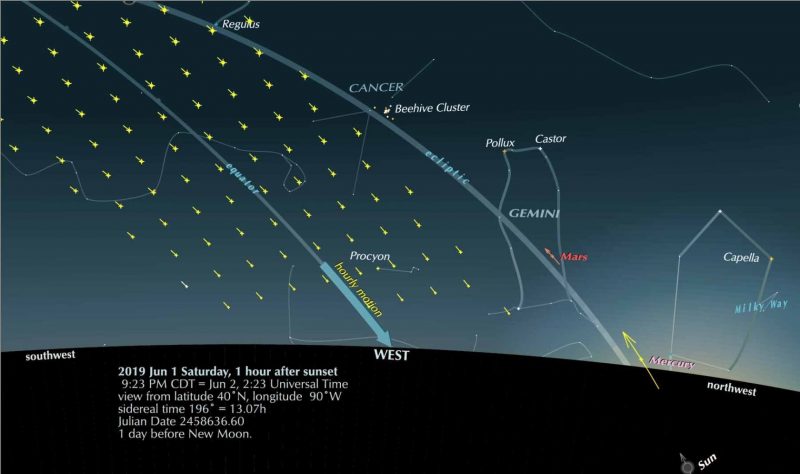

View larger. | Here is the evening sky for Saturday, June 1, 2019. Chart via Guy Ottewell’s blog.
Originally published at Guy Ottewell’s blog. Reprinted here with permission.
Editor’s Note: Skywatchers were awed last weekend to see a “train” of SpaceX Starlink satellites crossing the night sky. Many wanted to see them. Quickly, though, we began hearing rumbles from veteran observers about what will happen to our skies if and when SpaceX carries out its plan of deploying some 12,000 of these satellites. This post from astronomers Guy Ottewell is sure to be the first of many, expressing worry from lovers of Earth’s night skies.
The chart above shows the evening sky for Saturday, June 1, 2019.
Mars, traveling north of the northermost part of the ecliptic, was at its greatest declination north (more than 24°) on May 16. But it is still falling lower in the evening sky, to pass behind the sun on September 2. Mercury, moving in the opposite direction, came from behind the sun on May 21 and will be farthest out on June 23.
The moon is well below the horizon at this time – it will be new, passing the sun, on June 3. So the sky will be dark, if clear of clouds and of light-pollution.
But here is a guess at what this sky could look like after Elon Musk’s SpaceX company and nine others have launched their “constellations” of commercial satellites:

View larger. | Same chart as above, but with a best-guess addition of the SpaceX Starlink satellites, once they’re fully deployed. Chart via Guy Ottewell’s blog.
Musk’s first 60 Starlink satellites were blasted into space on May 30.
They were 280 miles up and crossing from horizon to horizon in about five minutes. Their eventual height will be 240 miles (450 km), so that they will be less bright but above the horizon for longer and in sunlight for longer. They will be visible for three or four hours after sunset and before sunrise, which means that in the summer they will be visible all night.
There will be a first 1,584 of these satellites, and eventually 12,000. They are to be used for internet communication. Besides SpaceX, nine other companies are working on this “global space internet.”
Astronomers, as quoted by an article in The Guardian, were “surprised.” One said:
Everyone’s quite surprised by how bright they are.
They experienced “dismay as they began to calculate the potentially drastic impact on people’s views of the cosmos.” One might expect them to have rather easily, and early, calculated the extra light added to the sky and the area of sky blocked for telescopes. And one might expect a science correspondent to write a more astronomy-literate sentence than “Since the satellites are higher than the Earth’s surface, they remain illuminated by sunlight after sunset here.”
On looking again at the article, I see that I may have been optimistic about the density. Here’s how the first “train” of Starlinks appeared as it went over Holland.
SpaceX Starlink objects train May 24, 2019, from Marco Langbroek on Vimeo.
Is our children’s view of the universe to be roofed off by these “constellations” of artificial satellites?
There is something of an analogy with the constellation, or procession, or ant-trail of people now to be seen on Mount Everest. This photograph of a couple of days ago gave me a sharp shock:

Crowd of hikers ascending the summit of Mount Everest. Image via Guy Ottewell’s blog.
Where is Sirius? Where is the long outdoors apprenticeship of getting to know the starry sky? Where is the epic of the gradual winning to the world’s summit?
Bottom line: Thoughts on possible damage to the night skies from the SpaceX Starlink satellites.
Read more: SpaceX satellites could blight the night sky, warn astronomers
from EarthSky http://bit.ly/2QD9zFd


View larger. | Here is the evening sky for Saturday, June 1, 2019. Chart via Guy Ottewell’s blog.
Originally published at Guy Ottewell’s blog. Reprinted here with permission.
Editor’s Note: Skywatchers were awed last weekend to see a “train” of SpaceX Starlink satellites crossing the night sky. Many wanted to see them. Quickly, though, we began hearing rumbles from veteran observers about what will happen to our skies if and when SpaceX carries out its plan of deploying some 12,000 of these satellites. This post from astronomers Guy Ottewell is sure to be the first of many, expressing worry from lovers of Earth’s night skies.
The chart above shows the evening sky for Saturday, June 1, 2019.
Mars, traveling north of the northermost part of the ecliptic, was at its greatest declination north (more than 24°) on May 16. But it is still falling lower in the evening sky, to pass behind the sun on September 2. Mercury, moving in the opposite direction, came from behind the sun on May 21 and will be farthest out on June 23.
The moon is well below the horizon at this time – it will be new, passing the sun, on June 3. So the sky will be dark, if clear of clouds and of light-pollution.
But here is a guess at what this sky could look like after Elon Musk’s SpaceX company and nine others have launched their “constellations” of commercial satellites:

View larger. | Same chart as above, but with a best-guess addition of the SpaceX Starlink satellites, once they’re fully deployed. Chart via Guy Ottewell’s blog.
Musk’s first 60 Starlink satellites were blasted into space on May 30.
They were 280 miles up and crossing from horizon to horizon in about five minutes. Their eventual height will be 240 miles (450 km), so that they will be less bright but above the horizon for longer and in sunlight for longer. They will be visible for three or four hours after sunset and before sunrise, which means that in the summer they will be visible all night.
There will be a first 1,584 of these satellites, and eventually 12,000. They are to be used for internet communication. Besides SpaceX, nine other companies are working on this “global space internet.”
Astronomers, as quoted by an article in The Guardian, were “surprised.” One said:
Everyone’s quite surprised by how bright they are.
They experienced “dismay as they began to calculate the potentially drastic impact on people’s views of the cosmos.” One might expect them to have rather easily, and early, calculated the extra light added to the sky and the area of sky blocked for telescopes. And one might expect a science correspondent to write a more astronomy-literate sentence than “Since the satellites are higher than the Earth’s surface, they remain illuminated by sunlight after sunset here.”
On looking again at the article, I see that I may have been optimistic about the density. Here’s how the first “train” of Starlinks appeared as it went over Holland.
SpaceX Starlink objects train May 24, 2019, from Marco Langbroek on Vimeo.
Is our children’s view of the universe to be roofed off by these “constellations” of artificial satellites?
There is something of an analogy with the constellation, or procession, or ant-trail of people now to be seen on Mount Everest. This photograph of a couple of days ago gave me a sharp shock:

Crowd of hikers ascending the summit of Mount Everest. Image via Guy Ottewell’s blog.
Where is Sirius? Where is the long outdoors apprenticeship of getting to know the starry sky? Where is the epic of the gradual winning to the world’s summit?
Bottom line: Thoughts on possible damage to the night skies from the SpaceX Starlink satellites.
Read more: SpaceX satellites could blight the night sky, warn astronomers
from EarthSky http://bit.ly/2QD9zFd

Aucun commentaire:
Enregistrer un commentaire